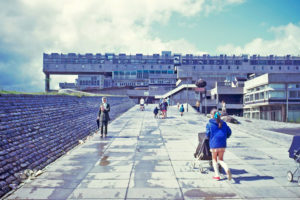When my aunt met my uncle, he was a pipe-smoking deerstalker, employed by a Highland estate to manage a herd of reds across some 20,000 acres. He had a team of terriers for fox control, he often rehabilitated injured birds of prey, and he helped reintroduce ospreys. He is also the only person I’ve ever met with a taxidermy wildcat, a beautiful bit of roadkill that he stuffed himself. Wildcats were once numerous in the ancient forestry around his house, but interbreeding with errant domestic tabbies means they are now all but gone.
Forty years ago, there would have hardly been a house on the peninsula that wasn’t lived in by somebody who wasn’t working the land. But like so much of the Highlands, its beauty has been its undoing and after the estate was sold off, a busy period of house-building began. My cousins got on board. Over the years, as well as farming, they’ve made hay out of holiday properties. But I do wonder, when my uncle’s out after deer at dawn, up on the hill, if he looks down to the coast and wonders about the part he’s played in taming a wild place he loved.
Last year, I drove through the West Highlands and on up to the Isle of Skye to talk to a young crofter about corncrakes. A little over 100 years ago, the corncrake’s strange “crex crex” call could be heard in spring, in most British counties. The latest counts suggest there are now fewer than 1,000 male corncrakes returning each year, almost all of them bound for Scotland’s northwestern periphery.
The crofter I was going to see, Cheryl, lives right at the other end from where the ferry docks, so I stopped for a beer in Armadale on my way. I realised, perched on a wall there, that I could see right across the water to my cousin’s house on the other side. “Your aunt won’t go to Skye anymore in the summer,” my mother replied when I texted her. “Traffic jams all across the island.” She was right. During my stay there were caravans backed up on the road to the Fairy Pools, there was never any parking in Portree, and an old farmer told me he’d given up on Highland cattle and gone into Galloways instead. “There were folks taking photos just non-stop and it doesn’t do to harass the cattle like that”.
The precipitous decline in corncrake numbers, in mainland Britain, has been largely caused by agricultural intensification. Corncrakes traditionally nested in hay meadows and the bulk of them would have fledged by the time the hay was cut. But with the advent of the tractor and the transition to silage, which is cut earlier, countless nests and chicks die beneath the blades. The crofting system in the Western Isles is far less intensive and there are schemes that provide financial incentives for crofters to delay cutting until the corncrakes have taken flight.
As Cheryl pointed out, lots of farmers have just given up completely on their marginal crofting operations and turned to tourism. “The corncrakes do need the grass to be cut, they don’t like rank vegetation, but people just stop farming. Instead now you’ve got sometimes three holiday houses per croft”. Climbing up into her tractor to get back to cutting the field, Cheryl said to me she’s not yet heard a corncrake on the island. A lot of her day-to-day life is taken up with crofting in a way that doesn’t theoretically endanger the few birds that remain, but she suspects there haven’t actually been any corncrakes in her part of Skye for some 20 years.
Still, the impact of tourism is more complicated than many people pretend. Magnus Davidson, whose work at the University of the Highlands and Islands focuses on setting out a new vision for rural Scotland, told me that he no longer goes to Skye in the summer either. It’s very easy, he admits, to condemn tourists, but in lots of places they are the lifeblood of rural economies and achieving any sort of balance is next to impossible. “When tourism starts to negatively affect things like roads or the environment, infrastructure can help alleviate the impact but when it comes to cultural degradation” — the loss of dialects and languages and even ways of living — “you can’t infrastructure your way out of that”. Magnus admits that there probably are parts of the UK where the tourism is harmonious but it’s ever-evolving. “It could be that somewhere is only ever one Instagram post away from the scales being tipped”.
Magnus was also keen to point out that too much low-cost tourism risks a place becoming flooded, but make it too expensive and you run the risk of exclusivity. In some instances, locals have to contend with both. Last month, in North Norfolk, where coastal cottages often change hands for over a million quid, I met an environmentalist who was on her way to a meeting about beachgoers peeing on the dunes at Wells. The quantity of urine there has become so great that it is having a serious ecological impact.
Tourism has been the ruin of many places, but parts of Scotland desperately need more of it. A little over six months ago, my parents left Dumfriesshire, a place of remarkable tranquillity, where most summer evenings, the sun casts the hills in heavy golden light. But the village pub had closed, like the village butcher, and the village shop before it. They could all have done with a few well-heeled holidaymakers in search of some local ales and a bit of beef for their smart new barbecues.
On Skye, the truth is that a crofter with three camping pods — on what was once fine corncrake habitat — can make more in a month out of people than they ever made in a year out of cattle. But that’s not to say that tourism is always necessarily terrible for wildlife. There are some places, such as Knepp Castle in Sussex, where the extraordinary recovery of birds has been facilitated by it. Nature was suffering there because of intensive agriculture, but the shift to making money out of people — out of shepherds’ huts, yurts, and pleasant places to pitch a tent — has meant they can manage the land in a far gentler and more ecologically sound way. In a binary world, we tend not to realise that there are different flavours of agriculture. Where the corncrakes of the Hebrides need farming, to keep the grass sward in check, farming in Sussex has done for turtle doves by tearing out hedgerow habitat in order to make fields bigger.
It was five or six years ago that I last went north to see my cousins. Beneath snipe drumming and harriers cutting circles in the air, I fished for a couple of days — just a few small brown trout and one sea trout lost. On the last evening I was there, my uncle said I could go down to his farm the following morning and shoot a goose if I fancied it — the greylags had been eating his animals’ grass for too long.
I drove to the bay before dawn and picked my way across the marsh before settling in behind a cattle trough. For 20 minutes the geese grew louder and louder out on the sand. Just before the sun rose they got up and passed me 30 yards to the right, dark shapes against a cold blue sky. I took one out of the back of the skein. Two shots sent it tumbling into the reeds and the marsh lifted with the crying shadows of curlew, lapwing, and dunlin.
Then behind me, all around the bay, lights came on in houses that I hadn’t realised were there. I wandered back along the lane with the warm goose tucked under my jacket. I didn’t want to spoil things for any of those holidaymakers, as they sat down to croissants and the picture postcard view.
Disclaimer
Some of the posts we share are controversial and we do not necessarily agree with them in the whole extend. Sometimes we agree with the content or part of it but we do not agree with the narration or language. Nevertheless we find them somehow interesting, valuable and/or informative or we share them, because we strongly believe in freedom of speech, free press and journalism. We strongly encourage you to have a critical approach to all the content, do your own research and analysis to build your own opinion.
We would be glad to have your feedback.
Source: UnHerd Read the original article here: https://unherd.com/




